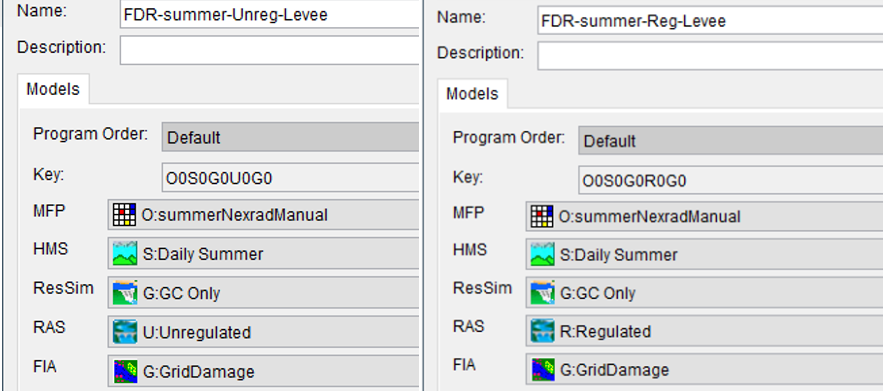HEC-FIA Individual Computes
This method, while still valid, has been largely replaced by advances in HEC-FIA, and new users are encouraged to follow the steps outlined in the HEC-FIA Holdout RAS HDF Compute. However, for the sake of completeness, we'll cover this approach here. It requires more data manipulation than the RAS Holdout HDF Compute, but it remains a feasible option.
Computing individual HEC-FIA damages separately is more complex. It involves multiple forecast runs and additional processing of consequence results outside of the CAVI. However, this method offers a few key advantages over the HEC-FIA Holdouts approach:
- Accurate Without-Levee Damages: It allows for calculating the "without levee" damages using HEC-RAS unsteady hydraulics instead of the assumptions used in HEC-FIA.
- Better Control Over Benefits: It gives you more control over how benefits are distributed between levees and reservoirs.
- More Comprehensive Damage Analysis: It allows you to calculate flood damages not just for structures, but also for agriculture.
This approach is particularly beneficial for large watersheds with complex levee systems, or when reservoirs have significant effects on damage results that extend beyond district boundaries.
What Does "Large Levees" Mean?
In this context, "large levees" refers to levee systems that have a substantial hydraulic impact on mainstem river stages when comparing the with-levee and without-levee scenarios. In other words, the hydraulic effects of the levees are so significant that the assumptions used in the HEC-FIA Holdouts method would not be appropriate for modeling the without levee condition.
The Four Essential Scenarios
To compute FDR for systems with multiple reservoirs and levees using this approach, you’ll need to run simulations for the following four scenarios:
- Regulated (Observed Condition): The situation with both reservoirs and levees in place.
- Unregulated: The condition with levees in place but no reservoirs.
- Regulated Without Levee: The condition with reservoirs but no levees.
- Unregulated Without Levee: The condition with neither reservoirs nor levees in place.
Once the total damages for these scenarios are computed within CWMS, you can begin the process of dividing the benefits between the reservoirs and the levees. This involves computing reservoir allocation percentages, determining damages reduced in leveed areas, and applying an allocation method to assign portions of the levee benefits to reservoirs. This detailed process is discussed further in the section on Analyzing Consequence Results.
Setting Up Your Watershed for FDR Computes
The remainder of this section focuses on the additional setup required for computing flood damages reduced for your watershed.
Forecast Runs
The data flow for the models is illustrated in the figure below, showing a typical forecast run for a watershed containing both reservoirs and levees. The model sequence (program order) is identical to a standard CWMS real-time forecast. However, to accommodate the four scenarios mentioned earlier, four forecast runs are required, each using a different HEC-RAS alternative. The results from these four simulations are then passed to HEC-FIA to calculate the total damages for each scenario.
Below are examples of forecast alternatives for each of the four scenarios. The key difference between the four scenarios is the HEC-RAS model alternative; all other model alternatives remain the same.

HEC-RAS Model Alternatives
In addition to the typical CWMS real-time setup, you’ll need to add three additional HEC-RAS alternatives to represent the necessary hydraulic scenarios. Detailed instructions on setting up these alternatives can be found in the HEC-RAS Model Setup section. Since this approach uses the standard HEC-FIA damage compute, there’s no need to create a new HEC-FIA alternative.